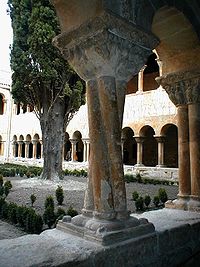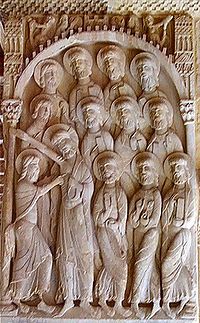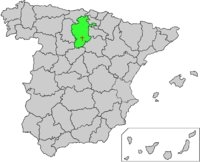- Abbey of Santo Domingo de Silos
-
Santo Domingo de Silos Abbey (Spanish: Monasterio de Santo Domingo de Silos) is a Benedictine monastery in the village of Santo Domingo de Silos in the southern part of Burgos Province in northern Spain. The monastery is named after the eleventh-century saint Dominic of Silos.
Contents
Romanesque architecture and sculpture
The two-storey cloister of the monastery, which has large capitals with carved scenes, and also relief panels, is considered a masterpiece of Romanesque art, and has been written about extensively, notably by Meyer Schapiro in his Romanesque Art (1977).[1] There is also an important Romanesque free-standing enthroned Madonna and Child.
Library
The monastery's scriptorium was an important one, which among other major books produced a finely illuminated Beatus manuscript (a commentary upon the Apocalypse); the text was completed (by two related monks) in 1091, but the illuminations (illustrations) were mostly done later by the prior, who finished his work in 1109. These include an important map of the Mediterranean regions. This is now in the British Library, having left the monastery by the 18th century. Other manuscripts were sold at auction in 1878, and are mostly in the British Library in London or the Bibliothèque nationale de France in Paris. The library still contains the Missal of Silos, the oldest Western manuscript on paper. Together with the library of Toledo Cathedral, the Silos Library was the main repository of liturgical manuscripts of the Mozarabic rite until the sale of 1878.
There is a historic pharmacy with a specialist library.[2]
Music in the abbey
The monks originally sang Mozarabic chant. At some point around the eleventh century they switched to Gregorian chant. In the nineteenth century the abbey became a member of the Solesmes Congregation, and the singing has since been influenced by the scholarship and performance style of Solesmes Abbey.
Recordings
The monks of Silos became internationally famous through the album Chant, one of a number of recordings they have made.[3] First released on LP, Chant became popular when re-released by Angel Records in 1994 and strongly marketed. It peaked at #3 on the Billboard 200 music chart, and was certified as triple platinum, becoming the best-selling album of Gregorian chant ever released. It was followed by Chant II (1995).
Access for the public
The cloisters and pharmacy are open to the public. Visitors are also able to attend services such as vespers in the abbey church, an eighteenth-century building designed by Ventura Rodríguez. Access to the library is restricted to researchers.
References
- ^ Schapiro, Meyer, From Mozarabic to Romanesque in Silos, in Selected Papers, volume 2, Romanesque Art, 1977, Chatto & Windus, London, ISBN 0701122390
- ^ (Spanish) E. Dolado, F.J. Martín Gil, J. Martín Gil. El fondo bibliográfico de la botica de Santo Domingo de Silos. In: Estudios sobre historia de la ciencia y de la técnica. IV Congreso de la Sociedad Española de Historia de las Ciencias y de las Técnicas. Valladolid, 22-27 de Septiembre de 1986. 1988, ISBN 84-505-7144-8, pags. 749-754
- ^ Selective Chant Discography
- Schapiro, Meyer, From Mozarabic to Romanesque in Silos, in Selected Papers, volume 2, Romanesque Art, 1977, Chatto & Windus, London, ISBN 0701122390
External links
Categories:- 929 establishments
- 920s architecture
- Benedictine monasteries in Spain
- Burgos Province
- Basilica churches in Spain
- Christian monasteries established in the 10th century
- Monasteries in Castile and León
- Pharmacy museums
- Romanesque architecture in Spain
- Spanish choirs
Wikimedia Foundation. 2010.



